Notes: From the south portal of Paxton tunnel the line splayed out into a series of sidings and the impressive terminus designed by Edward Middleton Barry and costing £100,000 to build. The station was built on an excavated ridge below Crystal Palace Parade requiring major engineering works and a high retaining wall.
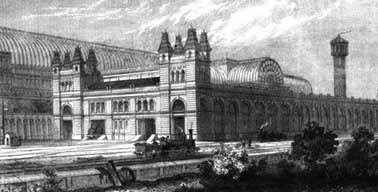 High Level Station adjacent to the Palace - Illustrated London News
High Level Station adjacent to the Palace - Illustrated London News
|
e The station was an outstanding example of Victorian architecture with high red and terra cotta brick side and end walls and a glass and iron trainshed roof. Square towers were added at each corner, each tower topped with 4 short spires. The station was divided longitudinally by a series of brick arches with a passenger concourse above th |
tracks at each end of the station incorporating a booking office, refreshment rooms and waiting rooms.
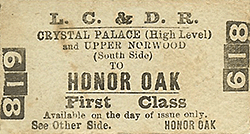 Four tracks entered the station through narrow openings at the London end serving two wooden platforms in each side of the station. The two inner lines had platform faces on both sides to speed the loading and unloading of the expected packed trains. At the far end of the station, the tracks passed through the end walls through a second series of narrow opening to a turntable beyond the bridge over Farquhar Road; this allowed trains to run round and avoid delays. Four tracks entered the station through narrow openings at the London end serving two wooden platforms in each side of the station. The two inner lines had platform faces on both sides to speed the loading and unloading of the expected packed trains. At the far end of the station, the tracks passed through the end walls through a second series of narrow opening to a turntable beyond the bridge over Farquhar Road; this allowed trains to run round and avoid delays.
One half of the station was intended for first class passengers, who were given segregated access in the centre transept of the Palace. A subway under Crystal Palace Parade linked the station directly with the Palace. The subway consisted of a wide vaulted and tiled chamber resembling a Byzantine crypt; it was designed and built by cathedral craftsmen brought over from Italy. The roof was supported by a series of octagonal pillars of red and cream brick interlaced with stone ribs. Steps led down from the main floor of the Palace into a further circulating area, adjacent to the subway.
Nine sidings were provided to cater for goods traffic and to stable additional locomotives and carriages that could be used to move large crowds away from the station when required; the station could cater for 7000 – 8000 passengers an hour.
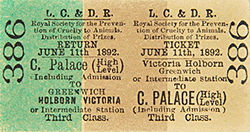 Sadly the station never fulfilled its potential. Although the opening of the Palace had encouraged the development of Sydenham and Upper Norwood as quality middle-class suburbs, the Palace itself was very much in decline as an attraction in the last decades of the Victorian era. By 1890, extensive repairs were required and ten years later, the Palace had been divided up into booths and stalls, making it look rather ‘seedy’. Sadly the station never fulfilled its potential. Although the opening of the Palace had encouraged the development of Sydenham and Upper Norwood as quality middle-class suburbs, the Palace itself was very much in decline as an attraction in the last decades of the Victorian era. By 1890, extensive repairs were required and ten years later, the Palace had been divided up into booths and stalls, making it look rather ‘seedy’.
In order to attract more residential traffic the LCDR renamed the terminus Crystal Palace High Level & Upper Norwood on 1 November 1898 but it did little to improve the stations prospects and those of the Palace also remained in decline. In 1909 the Crystal Palace Company went into receivership; the City of London Trust Fund was then established and part of the building used as a motor museum. During World War I the leaking Palace was employed as a barracks, but, thanks to the City funds, the building once again opened to the public in 1920 and was later used as a temporary War Museum.
Even after electrification passenger traffic remained low. A traffic census in February 1926 revealed that 53 trains between 6.05 am and 11.22pm brought only 653 passengers to the station with 703 departing.
The station was closed as an economy measure during both wars and during WW2 the extensive sidings were used to store rolling stock that had been made redundant by the war including buffet and second class boat train carriages. The subway and adjacent courtyard survived the 1936 fire and was used as an air raid shelter during the war.
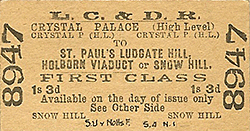 After the war, the station was in a very run down condition, much of the glass trainshed roof had been shattered during relentless bombing and no attempt was made to repair it allowing rain to pour in to the station. As a result the timber platforms were soon covered by vegetation with the rats scurrying under the platforms far outnumbering the passengers. By this time only one platform was in use with the northern stairs, concourse and booking office being abandoned to the elements while that at the other and was little used outside peak hours. Safety nets were draped from the roof to protect passengers from falling debris. After the war, the station was in a very run down condition, much of the glass trainshed roof had been shattered during relentless bombing and no attempt was made to repair it allowing rain to pour in to the station. As a result the timber platforms were soon covered by vegetation with the rats scurrying under the platforms far outnumbering the passengers. By this time only one platform was in use with the northern stairs, concourse and booking office being abandoned to the elements while that at the other and was little used outside peak hours. Safety nets were draped from the roof to protect passengers from falling debris.
After closure the crumbling structure survived until 1961 when the station was demolished leaving only the high retaining wall on the west side of Crystal Palace Parade, the vaulted subway beneath the road and the now roofless concourse at the east end of the subway. This is now a Grade 2 listed building and is occasionally opened for public visits.
Once the station site was cleared it was used for temporary car parking in the early 1960’s and in the mid 60’s an estate of prefabs was built on the site. These were however very short lived and eventually the site was redeveloped as a housing estate.
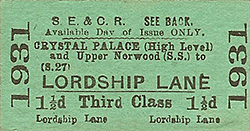 Over the years there have been a number of rumours relating to the High Level station. There is a rumour that in one of the sealed tunnels in the area, an engine or carriage remains hidden collecting dust. Another version of the story, popular amongst local schoolchildren, claims that the High Level station was closed because a commuter train was trapped by a tunnel collapse, entombing the passengers who remain there to this day. These stories are an example of the extraordinary persistence of local urban legend. The story of the entombed train was apparently current in the 1930s. Back then it referred to the abandoned 1860s pneumatic railway on the north side of the grounds of Crystal Palace Park. Over the years there have been a number of rumours relating to the High Level station. There is a rumour that in one of the sealed tunnels in the area, an engine or carriage remains hidden collecting dust. Another version of the story, popular amongst local schoolchildren, claims that the High Level station was closed because a commuter train was trapped by a tunnel collapse, entombing the passengers who remain there to this day. These stories are an example of the extraordinary persistence of local urban legend. The story of the entombed train was apparently current in the 1930s. Back then it referred to the abandoned 1860s pneumatic railway on the north side of the grounds of Crystal Palace Park.
| The Crystal Palace atmospheric or pneumatic railway was built in 1864 at the lower end of the Crystal Palace Park, and was working for a matter of months. It ran for about 600 yards in a 10ft diameter brick tunnel between the Sydenham and Penge gates to the Park. The tunnel had a gradient of 1 in 15 and the railway went round in a sharp curve. It had a coach which could seat 35, and a sliding door at each end. There was a remote steam engine coupled to a fan. The railway had a collar of |
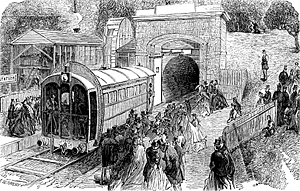 The pneumatic railway in Crystal Palace Park
The pneumatic railway in Crystal Palace Park ( click) |
bristles which made it airtight and enabled the coach to be sucked along - at a speed of probably 25 mph.
The engineer was Thomas Webster Rammell, a man behind other pneumatic railway experiments in London. Most traces of this had almost certainly been destroyed by the building works for the 1911 Festival of Empire, but there was an unsuccessful archaeological dig for the train sponsored by the BBC's Nationwide current affairs programme in the 1970s.
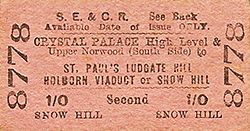 BRIEF HISTORY OF THE CRYSTAL PALACE HIGH LEVEL BRANCH BRIEF HISTORY OF THE CRYSTAL PALACE HIGH LEVEL BRANCH
The Great Exhibition in Hyde Park attracted just over six million visitors to the Crystal Palace between May and October 1851. After closure the structure was dismantled and in August 1852 the rebuilding began on a site at Sydenham Hill. The intention was to create a winter park and garden providing the finest display of rare plants and trees and to display replicas of the world’s finest statues; the reconstructed Palace was opened by Queen Victoria in June 1854. To cater for the expected huge influx of visitors the London Brighton & South Coast Railway (LBSCR) opened a station serving the area on 10th June 1854 but the station was not ideally sited and involved visitors walking along a 720ft glass covered colonnade. The station was called Crystal Palace but will be referred to here as ‘Low Level’, a name it didn’t actually get until 1898.
 |
The Crystal Palace and South London Junction Railway was authorised on 17.7.1862 to build a line from Peckham Rye to a large covered terminus alongside the Palace with a subway from one end of the station under the road into the grounds.
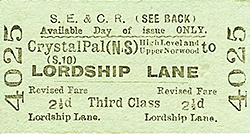 It was opened on 1.8.1865 from Cow Lane Junction east of Peckham Rye on the LBSCR to a terminus called Crystal Palace High Level; there were no intermediate stops with 19 trains a day running to and from Victoria, this was increased to 33 trains a day the following year. Two intermediate stations were opened later that year at Lordship Lane (1st September 1865)and Honor Oak (1st December 1865) and a further station was opened at Nunhead on 1st September 1871 to cater for a new housing development. It was opened on 1.8.1865 from Cow Lane Junction east of Peckham Rye on the LBSCR to a terminus called Crystal Palace High Level; there were no intermediate stops with 19 trains a day running to and from Victoria, this was increased to 33 trains a day the following year. Two intermediate stations were opened later that year at Lordship Lane (1st September 1865)and Honor Oak (1st December 1865) and a further station was opened at Nunhead on 1st September 1871 to cater for a new housing development.
Despite the terminus being conveniently sited, the branch came too late as the Crystal Palace excursion traffic was already falling as the Palace failed to attract the expected visitors. In 1866 a fire destroyed the north transept of the Palace and it was never rebuilt and a strong and successful opposition to Sunday opening further damaged its commercial prospects.
The CP & SLJR was incorporated into the London Chatham & Dover Railway in 1875 and five years later the LBSCR merged with the South Eastern Railway to become the South Eastern & Chatham Railway. The district was beginning to develop and another intermediate station was opened at Upper Sydenham on 1st August 1884.
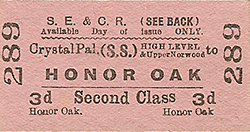 Despite more new housing in the 1880's and 1890's, the Crystal Palace High Level branch was poorly used as there was severe competition from the LBSCR lines, the three intermediate stations were all close to an LBSC station. The line's catchment area included cemeteries, very low density villa development and extensive open areas of the Dulwich College estate who had demanded restrictions prior to the building of the line imposing special architectural treatment of some of the railway structures. In 1908 there was further competition after the introduction of electric trams and later busses. Despite more new housing in the 1880's and 1890's, the Crystal Palace High Level branch was poorly used as there was severe competition from the LBSCR lines, the three intermediate stations were all close to an LBSC station. The line's catchment area included cemeteries, very low density villa development and extensive open areas of the Dulwich College estate who had demanded restrictions prior to the building of the line imposing special architectural treatment of some of the railway structures. In 1908 there was further competition after the introduction of electric trams and later busses.
One of the last great occasions at the Palace was the Festival of Empire and Imperial Exhibition held between May and October 1911 with the LBSCR and the SECR competing for passengers at the High Level and Low Level Stations. In the same year, to celebrate the coronation of King George V, the ‘Kings Fete’ was held at the Palace on 30th June with 105 special trains bringing over 100,000 people to the Palace, 47 of them to the High Level Station.
With manpower shortages during WW1, the High Level branch was expendable and the line was closed on 31.12.1916; it was reopened on 1.3.1919 to take advantage of the traffic generated from the demobilization centre at the Palace. Initially there was only a service to St. Paul’s (now Blackfriars) but the London Bridge service was reinstated from 9.7.1924.
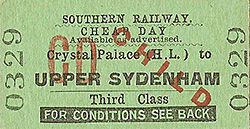 The service to the Low Level Station from London Bridge had been electrified in 1912 and the High Level line was included in the SECR electrification proposals of 1920 but nothing was done until the formation of the Southern Railway in 1923. As part of the electrification Nunhead Station was resited a short distance to the west on 3rd May 1925 and signalboxes at Nunhead Bank, Lordship Lane and Upper Sydenham were closed with only Crystal Palace and Honor Oak remaining in use. A sub station was built at Upper Sydenham with a shaft down to the Penge tunnel below providing a power cable connection. The third-rail electric service started on 12.7.1925 with a 20 minute service on weekdays from St. Paul’s. The service to the Low Level Station from London Bridge had been electrified in 1912 and the High Level line was included in the SECR electrification proposals of 1920 but nothing was done until the formation of the Southern Railway in 1923. As part of the electrification Nunhead Station was resited a short distance to the west on 3rd May 1925 and signalboxes at Nunhead Bank, Lordship Lane and Upper Sydenham were closed with only Crystal Palace and Honor Oak remaining in use. A sub station was built at Upper Sydenham with a shaft down to the Penge tunnel below providing a power cable connection. The third-rail electric service started on 12.7.1925 with a 20 minute service on weekdays from St. Paul’s.
There was some modest growth after electrification but traffic remained disappointing. A traffic census taken in February 1926 showed that the 53 departures from Crystal Palace High Level between 6.05 am and 11.22 pm carried only 703 passengers (less than one rush hour train load for the busiest London lines).
On 30th November 1936 the Palace was destroyed by fire attracting crowds far larger than any seen there for very many years and prompted the last special train for a Palace event with a train being provided for sore-eyed spectators in the early hours. After the fire, pleasure traffic dropped to virtually nothing and when the service was reduced as war time measure in 1940 the remaining passengers began to drift away to other Southern stations, trams and buses.
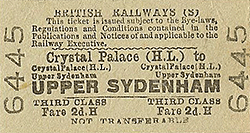 From 6th January 1941 the branch was worked as a shuttle to and from Nunhead but due to the wartime manpower shortage the line was closed on 21.5.1944. After the war, the line reopened on 4.1.1946 when the shuttle service was reintroduced with some peak hour trains to and from Blackfriars. Passenger numbers didn't improve however with many trains during the day running almost empty. With all the stations and the cabling requiring substantial repairs and renewal and no hope of traffic improvement and with more convenient facilities readily available, the line's fate was sealed. Closure was announced in January 1954 with the last electric train running on 18th September that year and the daily freight carrying domestic fuels to the yards at Honor Oak and High Level from Herne Hill ceased at the same time; this was the first permanent closure of an electrified line. On the following day a final steam excursion ran into High Level from Richmond. From 6th January 1941 the branch was worked as a shuttle to and from Nunhead but due to the wartime manpower shortage the line was closed on 21.5.1944. After the war, the line reopened on 4.1.1946 when the shuttle service was reintroduced with some peak hour trains to and from Blackfriars. Passenger numbers didn't improve however with many trains during the day running almost empty. With all the stations and the cabling requiring substantial repairs and renewal and no hope of traffic improvement and with more convenient facilities readily available, the line's fate was sealed. Closure was announced in January 1954 with the last electric train running on 18th September that year and the daily freight carrying domestic fuels to the yards at Honor Oak and High Level from Herne Hill ceased at the same time; this was the first permanent closure of an electrified line. On the following day a final steam excursion ran into High Level from Richmond.
Dismantling of the High Level branch proved a slow business occupying much of 1956 and early 1957. Once this had been completed the entire railway land between Nunhead and Crystal Palace was bought by the London County Council who passed it on to local councils for housing and open space development. Although all of the station sites have now been lost under new housing much of the remainder of the route can still be traced forming a five mile railway trail known as ‘From the nun’s head to the screaming Alice’. Both portals of the Paxton and Crescent Wood tunnels survive as does the ornate Coxes Walk footbridge which crosses the line south of Lordship Lane station site.
Tickets from Michael Stewart
Source: London's Local Railways by Alan A. Jackson - Published by David & Charles - 1978 & (2nd edition) 1999 - ISBN 0 7153 7479 6.
Other web sites: Abandoned Tube Stations, Crystal Palace Campaign and Southern E-Group
To see other stations on the Crystal Palace High Level branch click on the station name: Nunhead, Honor Oak, Lordship Lane & Upper Sydenham |

old1.jpg)
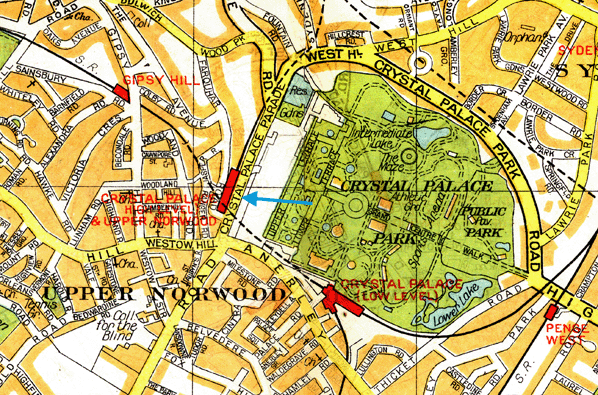
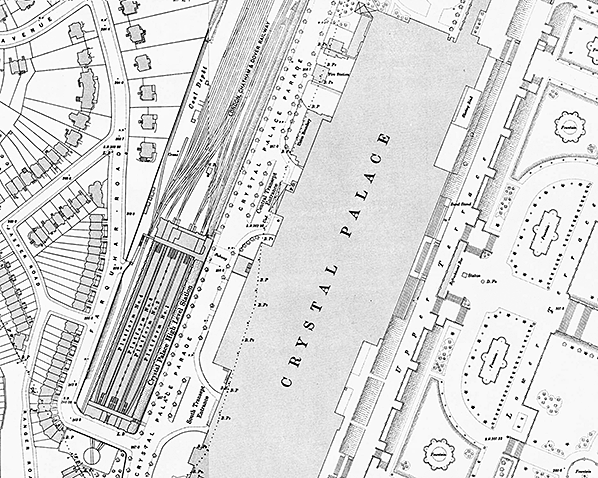
old14.jpg)
old22.jpg)
74.jpg)
level74.jpg)
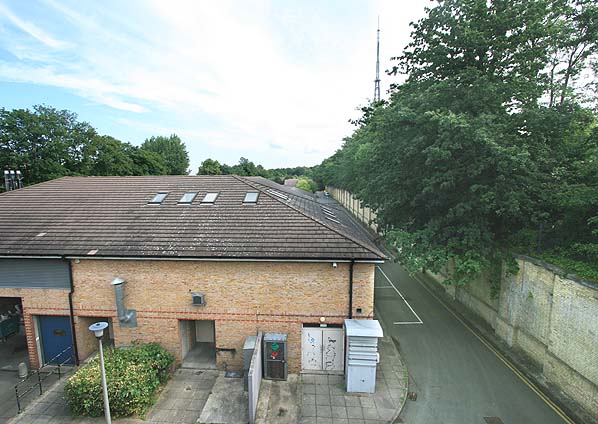
75.jpg)
 Home Page
Home Page 
 Four tracks entered the station through narrow openings at the London end serving two wooden platforms in each side of the station. The two inner lines had platform faces on both sides to speed the loading and unloading of the expected packed trains. At the far end of the station, the tracks passed through the end walls through a second series of narrow opening to a turntable beyond the bridge over Farquhar Road; this allowed trains to run round and avoid delays.
Four tracks entered the station through narrow openings at the London end serving two wooden platforms in each side of the station. The two inner lines had platform faces on both sides to speed the loading and unloading of the expected packed trains. At the far end of the station, the tracks passed through the end walls through a second series of narrow opening to a turntable beyond the bridge over Farquhar Road; this allowed trains to run round and avoid delays. Sadly the station never fulfilled its potential. Although the opening of the Palace had encouraged the development of Sydenham and Upper Norwood as quality middle-class suburbs, the Palace itself was very much in decline as an attraction in the last decades of the Victorian era. By 1890, extensive repairs were required and ten years later, the Palace had been divided up into booths and stalls, making it look rather ‘seedy’.
Sadly the station never fulfilled its potential. Although the opening of the Palace had encouraged the development of Sydenham and Upper Norwood as quality middle-class suburbs, the Palace itself was very much in decline as an attraction in the last decades of the Victorian era. By 1890, extensive repairs were required and ten years later, the Palace had been divided up into booths and stalls, making it look rather ‘seedy’. After the war, the station was in a very run down condition, much of the glass trainshed roof had been shattered during relentless bombing and no attempt was made to repair it allowing rain to pour in to the station. As a result the timber platforms were soon covered by vegetation with the rats scurrying under the platforms far outnumbering the passengers. By this time only one platform was in use with the northern stairs, concourse and booking office being abandoned to the elements while that at the other and was little used outside peak hours. Safety nets were draped from the roof to protect passengers from falling debris.
After the war, the station was in a very run down condition, much of the glass trainshed roof had been shattered during relentless bombing and no attempt was made to repair it allowing rain to pour in to the station. As a result the timber platforms were soon covered by vegetation with the rats scurrying under the platforms far outnumbering the passengers. By this time only one platform was in use with the northern stairs, concourse and booking office being abandoned to the elements while that at the other and was little used outside peak hours. Safety nets were draped from the roof to protect passengers from falling debris. Over the years there have been a number of rumours relating to the High Level station. There is a rumour that in one of the sealed tunnels in the area, an engine or carriage remains hidden collecting dust. Another version of the story, popular amongst local schoolchildren, claims that the High Level station was closed because a commuter train was trapped by a tunnel collapse, entombing the passengers who remain there to this day. These stories are an example of the extraordinary persistence of local urban legend. The story of the entombed train was apparently current in the 1930s. Back then it referred to the abandoned 1860s pneumatic railway on the north side of the grounds of Crystal Palace Park.
Over the years there have been a number of rumours relating to the High Level station. There is a rumour that in one of the sealed tunnels in the area, an engine or carriage remains hidden collecting dust. Another version of the story, popular amongst local schoolchildren, claims that the High Level station was closed because a commuter train was trapped by a tunnel collapse, entombing the passengers who remain there to this day. These stories are an example of the extraordinary persistence of local urban legend. The story of the entombed train was apparently current in the 1930s. Back then it referred to the abandoned 1860s pneumatic railway on the north side of the grounds of Crystal Palace Park. 
 BRIEF HISTORY OF THE CRYSTAL PALACE HIGH LEVEL BRANCH
BRIEF HISTORY OF THE CRYSTAL PALACE HIGH LEVEL BRANCH
 It was opened on 1.8.1865 from Cow Lane Junction east of Peckham Rye on the LBSCR to a terminus called Crystal Palace High Level; there were no intermediate stops with 19 trains a day running to and from Victoria, this was increased to 33 trains a day the following year. Two intermediate stations were opened later that year at Lordship Lane (1st September 1865)and Honor Oak (1st December 1865) and a further station was opened at Nunhead on 1st September 1871 to cater for a new housing development.
It was opened on 1.8.1865 from Cow Lane Junction east of Peckham Rye on the LBSCR to a terminus called Crystal Palace High Level; there were no intermediate stops with 19 trains a day running to and from Victoria, this was increased to 33 trains a day the following year. Two intermediate stations were opened later that year at Lordship Lane (1st September 1865)and Honor Oak (1st December 1865) and a further station was opened at Nunhead on 1st September 1871 to cater for a new housing development.  Despite more new housing in the 1880's and 1890's, the Crystal Palace High Level branch was poorly used as there was severe competition from the LBSCR lines, the three intermediate stations were all close to an LBSC station. The line's catchment area included cemeteries, very low density villa development and extensive open areas of the Dulwich College estate who had demanded restrictions prior to the building of the line imposing special architectural treatment of some of the railway structures. In 1908 there was further competition after the introduction of electric trams and later busses.
Despite more new housing in the 1880's and 1890's, the Crystal Palace High Level branch was poorly used as there was severe competition from the LBSCR lines, the three intermediate stations were all close to an LBSC station. The line's catchment area included cemeteries, very low density villa development and extensive open areas of the Dulwich College estate who had demanded restrictions prior to the building of the line imposing special architectural treatment of some of the railway structures. In 1908 there was further competition after the introduction of electric trams and later busses. The service to the Low Level Station from London Bridge had been electrified in 1912 and the High Level line was included in the SECR electrification proposals of 1920 but nothing was done until the formation of the Southern Railway in 1923. As part of the electrification Nunhead Station was resited a short distance to the west on 3rd May 1925 and signalboxes at Nunhead Bank, Lordship Lane and Upper Sydenham were closed with only Crystal Palace and Honor Oak remaining in use. A sub station was built at Upper Sydenham with a shaft down to the Penge tunnel below providing a power cable connection. The third-rail electric service started on 12.7.1925 with a 20 minute service on weekdays from St. Paul’s.
The service to the Low Level Station from London Bridge had been electrified in 1912 and the High Level line was included in the SECR electrification proposals of 1920 but nothing was done until the formation of the Southern Railway in 1923. As part of the electrification Nunhead Station was resited a short distance to the west on 3rd May 1925 and signalboxes at Nunhead Bank, Lordship Lane and Upper Sydenham were closed with only Crystal Palace and Honor Oak remaining in use. A sub station was built at Upper Sydenham with a shaft down to the Penge tunnel below providing a power cable connection. The third-rail electric service started on 12.7.1925 with a 20 minute service on weekdays from St. Paul’s. From 6th January 1941 the branch was worked as a shuttle to and from Nunhead but due to the wartime manpower shortage the line was closed on 21.5.1944. After the war, the line reopened on 4.1.1946 when the shuttle service was reintroduced with some peak hour trains to and from Blackfriars. Passenger numbers didn't improve however with many trains during the day running almost empty. With all the stations and the cabling requiring substantial repairs and renewal and no hope of traffic improvement and with more convenient facilities readily available, the line's fate was sealed. Closure was announced in January 1954 with the last electric train running on 18th September that year and the daily freight carrying domestic fuels to the yards at Honor Oak and High Level from Herne Hill ceased at the same time; this was the first permanent closure of an electrified line. On the following day a final steam excursion ran into High Level from Richmond.
From 6th January 1941 the branch was worked as a shuttle to and from Nunhead but due to the wartime manpower shortage the line was closed on 21.5.1944. After the war, the line reopened on 4.1.1946 when the shuttle service was reintroduced with some peak hour trains to and from Blackfriars. Passenger numbers didn't improve however with many trains during the day running almost empty. With all the stations and the cabling requiring substantial repairs and renewal and no hope of traffic improvement and with more convenient facilities readily available, the line's fate was sealed. Closure was announced in January 1954 with the last electric train running on 18th September that year and the daily freight carrying domestic fuels to the yards at Honor Oak and High Level from Herne Hill ceased at the same time; this was the first permanent closure of an electrified line. On the following day a final steam excursion ran into High Level from Richmond. 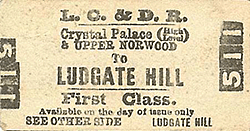
old4.jpg)
